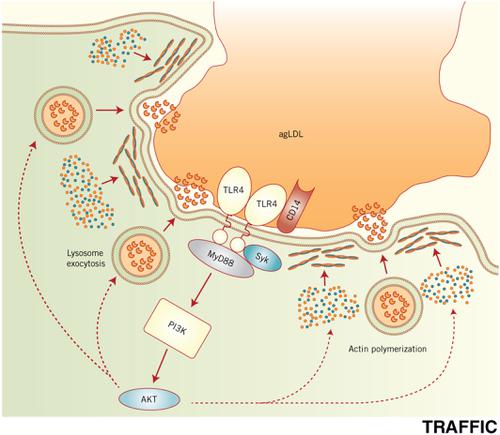Our official English website, www.x-mol.net, welcomes your
feedback! (Note: you will need to create a separate account there.)
Digestive exophagy: Phagocyte digestion of objects too large for phagocytosis.
Traffic ( IF 3.6 ) Pub Date : 2019-12-02 , DOI: 10.1111/tra.12712 Frederick R Maxfield 1 , Valeria C Barbosa-Lorenzi 1 , Rajesh K Singh 1
Traffic ( IF 3.6 ) Pub Date : 2019-12-02 , DOI: 10.1111/tra.12712 Frederick R Maxfield 1 , Valeria C Barbosa-Lorenzi 1 , Rajesh K Singh 1
Affiliation

|
Mammalian phagocytes carry out several essential functions, including killing and digesting infectious organisms, clearing denatured proteins, removing dead cells and removing several types of debris from the extracellular space. Many of these functions involve phagocytosis, the engulfment of a target in a specialized endocytic process and then fusion of the new phagosome with lysosomes. Phagocytes such as macrophages can phagocytose targets that are several micrometers in diameter (eg, dead cells), but in some cases they encounter much larger objects. We have studied two such examples in some detail: large deposits of lipoproteins such as those in the wall of blood vessels associated with atherosclerosis, and dead adipocytes, which are dozens of micrometers in diameter. We describe a process, which we call digestive exophagy, in which macrophages create a tight seal in contact with the target, acidify the sealed zone and secrete lysosomal contents into the contact zone. By this process, hydrolysis by lysosomal enzymes occurs in a compartment that is outside the cell. We compare this process to the well characterized digestion of bone by osteoclasts, and we point out key similarities and differences.
中文翻译:

消化性吞噬:吞噬能力过大的物体的吞噬细胞消化作用。
哺乳动物吞噬细胞具有多种基本功能,包括杀死和消化传染性生物,清除变性蛋白质,清除死细胞以及清除细胞外空间中的几种碎片。这些功能中的许多功能涉及吞噬作用,在专门的内吞过程中吞噬靶标,然后将新吞噬体与溶酶体融合。吞噬细胞(例如巨噬细胞)可以吞噬直径为几微米的靶标(例如,死细胞),但在某些情况下,它们会遇到更大的物体。我们已经详细研究了两个这样的例子:脂蛋白的大量沉积物,例如与动脉粥样硬化相关的血管壁中的脂蛋白沉积物,以及死亡的脂肪细胞,其直径为数十微米。我们描述了一个过程,我们称其为消化外溢,其中巨噬细胞产生与靶标接触的紧密密封,酸化密封区并将溶酶体内容物分泌到接触区。通过该过程,溶酶体酶的水解发生在细胞外部的隔室中。我们将这一过程与破骨细胞对骨的良好消化特性进行了比较,并指出了关键的相似点和不同点。
更新日期:2019-12-19
中文翻译:

消化性吞噬:吞噬能力过大的物体的吞噬细胞消化作用。
哺乳动物吞噬细胞具有多种基本功能,包括杀死和消化传染性生物,清除变性蛋白质,清除死细胞以及清除细胞外空间中的几种碎片。这些功能中的许多功能涉及吞噬作用,在专门的内吞过程中吞噬靶标,然后将新吞噬体与溶酶体融合。吞噬细胞(例如巨噬细胞)可以吞噬直径为几微米的靶标(例如,死细胞),但在某些情况下,它们会遇到更大的物体。我们已经详细研究了两个这样的例子:脂蛋白的大量沉积物,例如与动脉粥样硬化相关的血管壁中的脂蛋白沉积物,以及死亡的脂肪细胞,其直径为数十微米。我们描述了一个过程,我们称其为消化外溢,其中巨噬细胞产生与靶标接触的紧密密封,酸化密封区并将溶酶体内容物分泌到接触区。通过该过程,溶酶体酶的水解发生在细胞外部的隔室中。我们将这一过程与破骨细胞对骨的良好消化特性进行了比较,并指出了关键的相似点和不同点。











































 京公网安备 11010802027423号
京公网安备 11010802027423号